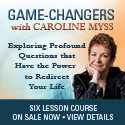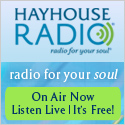Instant hands-free Reiki self-care
After last week's post on Reiki self-care, I heard from a few readers who protested that they just don't have time for self-care every day, or they don't always have a private place to practice hands-on. I'll agree that most of us are way too busy these days, with packed schedules, hectic commutes, and obligations in all directions. But every one of us has time for a little self-care now and then during our busy days. Here are 10 ways to give yourself an instant energy shift with Reiki in complete privacy even in public.
1) Use a precept. When you notice yourself feeling stressed, choose whichever Reiki precept seems most appropriate to your situation and say it to yourself, once or many times. For example, if you're driving and another driver cuts in front of you, almost causing an accident, you might react with anger. You might also notice that your heart is pounding. The precipitating event is over, but your body is still in alarm mode. Tell yourself, "Do not anger." Repeat as necessary. The other Reiki precepts can be used in much the same way.
2) Ground yourself with earth energy. Stand with your feet flat on the floor, pointed straight ahead, about shoulder width apart. Imagine yourself sending your energetic roots down through your feet, through the floor, and deep into the earth. Breathe into your lower abdomen (lower hara, tanden). If you're on your way to an important meeting, and feeling apprehensive about it, try this as you wait for the elevator or before you go into the room.
3) Reach to the skies. Focus on the crown of your head. Imagine you are being pulled upward from that spot, by a string reaching up into the heavens. Feel your chin drop, your jaw relax, and your spine straighten. Try this early in the morning, or during a boring afternoon meeting.
4) Feel the connection. Combine the two previous methods and feel yourself stretching energetically in both directions.
5) Visualize yourself. Imagine yourself standing or sitting in front of yourself. Focus on sending Reiki energy with your eyes to whichever part of your visualized self seems to need it most. Can be done with eyes closed or open, and should not be done while driving.
6) Breathe. Use one or more Reiki breathing techniques to rebalance yourself without anyone around you even noticing. Try it next time you're waiting in line at the post office or supermarket.
7) Have a ball: This is usually done with the hands, but if you exercise your imagination you can do it without. Visualize a small ball of energy, about the size of a baseball, in front of you. As you inhale, visualize that energy ball getting larger and more diffuse. As you exhale, imagine it getting smaller again. Let it get as big as a basketball, small as a ping-pong ball, as big as a beach ball or as tiny as a marble. Also not recommended while driving.
8) Inhale the energy. Can be done anywhere, anytime. As you breathe in, imagine that Reiki energy is being drawn into your body along with the air going into your lungs. Now imagine that energy traveling to whatever part of you needs it: if your left knee is sore, for example, feel the energy going there. Don't forget to exhale, and as you do, let the pain, stiffness, and stale energy go out with your breath. Repeat as desired.
9) Use a symbol (Reiki 2 and above). Visualize it, or draw it in your mind or with your eyes or nose. Repeat until you feel an energy shift. Not recommended while driving.
10) Use a jumon (mantra) (Reiki 2 and above). Even if you can't safely draw or visualize a symbol when you're driving or otherwise need to keep your eyes on your task, you can use what Western Reiki traditions consider the names of the symbols without the visual component.
Even if you don't have time for a full self-care session, try one or more of these (or other Reiki techniques) now and then throughout the day. I do.
Speaking of energy practices, I'm happy to bring you some exciting news. Beginning July 11, I'll be teaching an early-morning Qigong class, Easy Energy Exercises for Everyone, at Moonheart Healing Arts Center, 59 W. 19th St., New York, New York, every Wednesday beginning July 11. Class starts at 8 a.m. and the cost is $10. What does that have to do with Reiki? Mikao Usui, the founder of Reiki, practiced qigong himself (called kiko in Japanese) from boyhood.
After telling us about her visit to Reiki birthplace Mt. Kurama in Japan and following up with some advice about etiquette for visiting temples, this week Special Correspondent Michelle Shinagawa introduces us to an 800-year-old tree, and a 21st-century webcam where you can monitor temple visits from anywhere in the world.
Reiki turns up on the London stage this week: one of the characters in the play "The Five Wives of Maurice Pinder" is a Reiki practitioner. Otherwise, however, the play seems to have very little to do with Reiki.
This week's Celeb-Reiki is British television and radio personality Fearne Cotton, who recently scored a big "get" when she interviewed Princes William and Harry about the 10th anniversary of the death of their mother, Princess Diana. Cotton told a reporter for The Independent that her mother "loves alternative therapy and Reiki but is by no means a hippie, in fact she's uber-glam" -- so does that make Reiki "uber-glam" too?
In Chapel Hill, North Carolina, a Reiki Master introduces a group of cancer survivors to chanting and dancing.
This week's edition of The Reiki Show podcast from Bronwen and Frans Stiene of the International House of Reiki is part two of "Japanese Arts and Ways."
There are still spaces available in the October Shinpiden (Master/Teacher level) course with Frans Stiene in New York City, sponsored by The Reiki Digest. For more information, contact: editor@thereikidigest.com
Rest in peace
Reiki Master Heidi Jo Zinda, 42, Sedona, Arizona
Reiki practitioner Sheila F. Goldstein, 60, of Upper Southampton, Pennsylvania

































